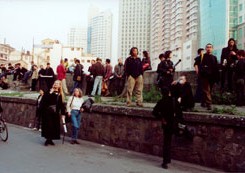During an interview, Ai Weiwei fervently declared, “We do not cooperate with anyone, anything. This is a challenge to all the powers, authorities and the system. It is small yet not to be ignored, like a nail in the eye, a thorn in the flesh, a little grain of sand in the shoe—it reflects a valuable cultural spirit” (1). Feng Boyi further clarified, “Do not cooperate with the contemporary mainstream trend in China, do not cooperate with the established structure of today’s art world, do not cooperate with the Western standard” (2).
For a long time after the opening night, there was much public discussion and media response, which directly lead to the forming of a legislative “notice” in April 2001 which included “forbidding performance or display of bloody, violent, and obscene subjects, as well as presentation of human reproductive organs or other pornographic acts that are harmful to the society” (3). The 2002 Shanghai Biennale Committee also posted the “lawyer authorization declaration” in major newspapers, as an attempt to suppress any “external exhibition”.
Dating back as early as the May 4th Movement in 1919, Chinese intellectuals have undertaken radical action in response to social and cultural problems. The “radical” art movement that began in the late 1970s, after traveling a bumpy road for two decades, finally gave its “last breath” before it eventually submitted to a new regime of the contemporary art world. I considered “Fuck Off” to be this “last breath.” Even though the fundamental concepts of radical art are based on rationalism, it was also romantic in a political sense, with a belief in abstract liberation as well as reckless fanaticism enlivened in a tangible form.
The radical art movement may have been continually changing its form, yet it did not do so just for the sake of form. An ideology to oppose the orthodox was its main focus; they were the pioneers leading to a “road of liberation.” The distinctive features of these kinds of exhibitions in the 1990s included refusing to be involved in a conventional exhibiting system, risking being cut short or closed down for their radical approaches, proclaiming their status as the avant-garde with radical actions and gestures, and having difficulties with spaces and funding. The idea, the scope of “Fuck Off” and the breadth of its effects were substantial enough to be qualified as the concluding show of this radical movement. It may not have realized its own destiny then. “Fuck Off” appeared to have concluded a dynamic that had thrived for two decades, where artists conceived and created their own exhibitions. The time was, however, already moving into the era of the curator.
The Chinese translation of the exhibition is both sensible and literal, “the way to not cooperate,” as opposed to the English interpretation, which on the contrary, in an expressionist way, serves the meaning on a metaphysical level. Though the approaches vary, the two translations nonetheless agree in essence. However, the English profanity reveals much about an artistic trend of the late 1990s. Many of the exhibition’s young and emerging artists were actively involved in the underground art scene then, and many artists sought maximum sensual excitement from and stimulation in their works. Additionally, “Fuck Off” unexpectedly terminated the efflorescence of that particular group of art “radicals.” Other exhibitions which extensively employed human and animal cadavers were “Post-Sense Sensibility: Alien Bodies & Delusion” (Beijing, 1999), “Indulge in Hurt” (Beijing, 2000), and “Human and Animal” (Nanjing, 2000). This movement lasted for about a year or two until criticism and reflection created by the controversial “Eating Baby” artworks and its successors brought a sudden end to this shock art contest.
Notes:
(1) “Dialogue on the ‘Fuck Off’ Exhibition,” an interview with Long Yong. The original article was published in Art World magazine in 2001; see here.
(2) Ibid.
(3) “Notice by the Cultural Department to strictly prohibit performance or display of bloody, violent, and obscene subjects on behalf of ‘art,’” Government Issue No. 14, April 3, 2001.
